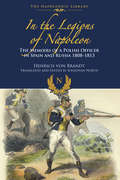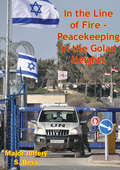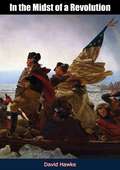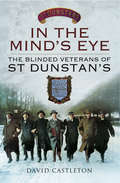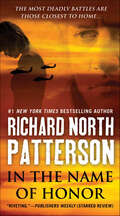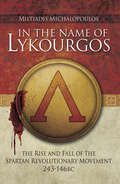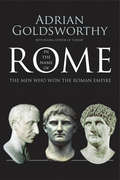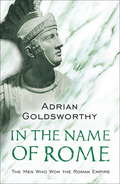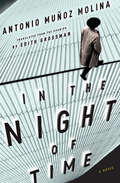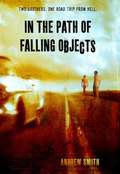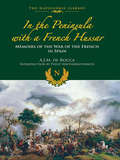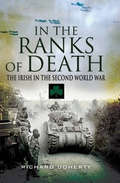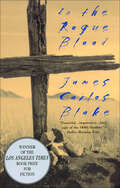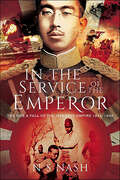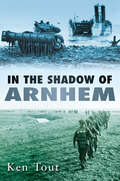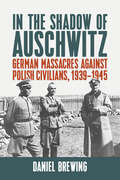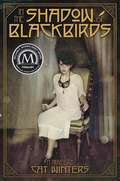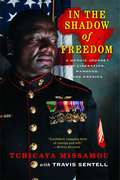- Table View
- List View
In the Legions of Napoleon: The Memoirs of a Polish Officer in Spain and Russia, 1808–1813 (The Napoleonic Library)
by Henrich von BrandtIn the Legions of Napoleon recounts the adventures of an intrepid Polish soldier who fought for Napoleon the length and breadth of Europe. By the time he was twenty-five, Heinrich von Brandt had marched from Madrid to Moscow and had been severely wounded on three separate occasions. From 1808 to 1812 he was caught up in Napoleons attempt to subjugate Spain, fighting in battles, sieges including the siege of Saragossa and hunting and being hunted by merciless bands of guerrillas. In 1812 his unit took part in the crossing of the Niemen and the epic retreat from Moscow.In his extraordinary memoirs Brandt describes in great detail the actions in which he fought, the type of officers and men he served with, and the grueling campaigns in which they participated. He also gives fascinating insight into the minds of his comrades and superiors. This book is a must for every Napoleonic historian, enthusiast, and anyone who likes a good story of high adventure.
In the Light of the Sun: A Novel
by Angela ShupeTwo sisters, separated by oceans and global conflict, are bonded through music and love in this gripping novel based on true events from World War II.&“Hauntingly beautiful . . . shines a light on wartime in the Philippines and Italy, places rarely depicted in historical fiction . . . a riveting, unforgettable must-read novel that will live in my heart and mind for years to come.&”—Sharon Kurtzman, author of The Lost Baker of Vienna The year is 1941, and in the Philippines, Caramina Grassi dreams of training in Italy to become an opera singer like her older sister, Rosa. But as war erupts, her world is shattered, forcing her to cling to the music that has always been her refuge. When her family&’s lives are threatened and they are forced to flee to the jungle, she comes to understand that music is more than comfort. It becomes a muse that fuels her courage, sacrifice, and unwavering focus on the light.Meanwhile, in Florence, just as Rosa Grassi&’s long-awaited opera debut arrives, Mussolini tightens his grip on Italy. Drawn into la Resistenza, the underground resistance, Rosa feels lost in a fog of deception that clouds everything she thought to be true. In a time when family or friend could be foe, Rosa will learn that performing isn&’t just for the stage. Facing a devastating betrayal, she must decide how far she&’s willing to go to protect the one she loves.Inspired by true events, In the Light of the Sun is an unforgettable story of sisterhood, hope, and the enduring power of music to uplift the human spirit—even in the darkest of times.
In the Line of Fire - Peacekeeping in the Golan Heights
by Major Jeffery S. BessThis monograph examines the considerations involved in maintaining a peacekeeping force in the Golan Heights. The examination is based on the assumption that Israel and Syria have reached an agreement concerning the Golan Heights and that the United States is going to establish a peacekeeping force in the Golan Heights.The monograph first examines the historical background of the area since the 1967 War. Based on this examination and on lessons learned from previous UN and other multinational peacekeeping operations, the monograph addresses national composition of the force, command of the peacekeeping force, and force structure. Next, based on the military and political aspects of the region, the monograph addresses the future peacekeeping force commander's concerns with military credibility, freedom of movement, and force protection.The study concludes with a summary evaluation of the necessary size and type of force for future peacekeeping in the Golan Heights. Based on the assumption and an analysis of the political and military considerations, future peacekeeping operations in the Golan Heights would require a MFO type force under the command and control of the United States. Due to the essential requirement for force protection due to the potential of pre-emption by either Israel or Syria and of terrorist attacks, a heavy brigade would be the most effective force in maintaining the peace while protecting the force.
In the Midst of a Revolution
by David HawkeIn the Midst of a Revolution, originally published in 1961, provides a social history of Pennsylvania in the months before Independence, based on contemporary diaries and newspapers. The author, Dr. David Freeman Hawke, a teacher at Pace University in New York City, examines the events of Pennsylvania in 1776, which made it possible to overthrow the venerable Charter of Privileges of 1701, and to replace it with the more democratic Constitution of 1776.A useful book with informative footnotes and an extensive bibliography.
In the Mind's Eye: The Blinded Veterans of St Dunstan's
by David CastletonDiscover the stories of the men and women who sacrificed their sight for their country. Since 1915 St Dunstan's (now Blind Veterans UK) has helped thousands of war-blinded men and women to rejoin society and live their lives to the full. This compelling book includes new research from the St Dunstan's archive and previously untold stories of the people, both blind and sighted, involved in the charity during the First and Second World Wars. St Dunstan's was founded by Sir Arthur Pearson, a blind press baron determined to prove that the blind could make a valuable contribution to society. Early St Dunstaners played football against Arsenal; learned to read braille, type, row and even shoot; and trained for new careers as masseurs, carpenters, switchboard operators and gardeners. As PR officer at St Dunstan's for 35 years, David Castleton worked with many of the men and women whose stories he tells in his book, and provides a unique insight into their achievements. Meet irrepressible Tommy Milligan, who lost his sight just months after enlisting on his eighteenth birthday, and Ian Fraser, blinded on the Somme, but later president of St Dunstan's. David Bell, who lost his hands and sight in a North African mine-field, yet found hope and a wife at St Dunstan's. War-blinded servicewomen also joined the charity during the Second World War, including 22-year-old Gwen Obern, blinded and maimed in a factory accident but later famed for her singing, and ATS sergeant Barbara Bell, who became a top physiotherapist.
In the Name of Honor: A Thriller
by Richard North Patterson“An absolute humdinger of a murder mystery . . . unrelenting suspense [and] a close look at the dysfunctions of military justice and of one particular family.” —Scott Turow, #1 New York Times–bestselling author of Presumed InnocentA “riveting legal thriller” by the #1 New York Times–bestselling author of Trial (Publishers Weekly, starred review)The McCarrans and the Gallaghers have been close for decades, ever since Anthony McCarran—now one of the army’s most distinguished generals—met Jack Gallagher, a fellow West Pointer later killed in Vietnam. Now a new generation faces combat, and Lt. Brian McCarran, the general’s son, has returned from a harrowing tour in Iraq.Traumatized by experiences he will not reveal, Brian depends on his lifelong friendship with Kate Gallagher, who’s married to Brian’s commanding officer, Capt. Joe D’Abruzzo. But D’Abruzzo also seems changed by the experiences he and Brian shared in Iraq, growing secretive and remote.Tragedy strikes when Brian shoots and kills D’Abruzzo on their Virginia army post. He pleads self-defense. Kate backs him up, saying her husband had turned violent and abusive. But Brian and Kate have their own secrets, and now Capt. Paul Terry, an accomplished young JAG lawyer, must defend Brian in a high-profile court-martial. Before the case is over, Terry will become deeply entwined with the McCarrans—and learn that families, like war, can break the sturdiest of souls.“Powerful . . . Patterson long ago established himself as one of the nation’s best writers of serious thrillers, and his latest novel burnishes his reputation.” —Richmond Times-Dispatch“Readers will find themselves engrossed as well as pleased by a twist revealing that there’s more to this powerful yet seemingly straightforward story than first meets the eye.” —Booklist“Patterson’s insights into PTSD are fascinating but never interrupt the story’s flow to its explosive ending, and his courtroom drama is as intensely engaging as the most action-filled thrillers.” —Library Journal (starred review)
In the Name of Humanity
by Max WallaceThe untold true story of the secret negotiations--by the most unlikely figures--to end the Holocaust On November 25, 1944, prisoners at Auschwitz heard a deafening explosion. Emerging from their barracks, they witnessed the crematoria and gas chambers--part of the largest killing machine in human history--come crashing down. Most assumed they had fallen victim to inmate sabotage and thousands silently cheered. However, the Final Solution's most efficient murder apparatus had not been felled by Jews, but rather by the ruthless architect of mass genocide, Reichsführer-SS Heinrich Himmler. It was an edict that has puzzled historians for more than six decades. Holocaust historian and New York Times bestselling author Max Wallace--a veteran interviewer for Steven Spielberg's Shoah Foundation--draws on an explosive cache of recently declassified documents and an account from the only living eyewitness to unravel the mystery. He uncovers an astounding story involving the secret negotations of an unlikely trio--a former fascist President of Switzerland, a courageous Orthodox Jewish woman, and Himmler's Finnish osteopath--to end the Holocaust, aided by clandestine Swedish and American intelligence efforts. He documents their efforts to deceive Himmler, who, as Germany's defeat loomed, sought to enter an alliance with the West against the Soviet Union. By exploiting that fantasy and persuading Himmler to betray Hitler's orders, the group helped to prevent the liquidation of tens of thousands of Jews during the last months of the Second World War, and thwarted Hitler's plan to take "every last Jew" down with the Reich. Deeply researched and dramatically recounted, In the Name of Humanity is a remarkable tale of bravery and audacious tactics that will help rewrite the history of the Holocaust.
In the Name of Humanity: The Secret Deal to End the Holocaust
by Max WallaceShortlisted for the 2018 RBC Taylor prize for literary nonfiction“A riveting tale of the previously unknown and fascinating story of the unsung angels who strove to foil the Final Solution.”—Kirkus starred reviewOn November 25, 1944, prisoners at Auschwitz heard a deafening explosion. Emerging from their barracks, they witnessed the crematoria and gas chambers--part of the largest killing machine in human history--come crashing down. Most assumed they had fallen victim to inmate sabotage and thousands silently cheered. However, the Final Solution's most efficient murder apparatus had not been felled by Jews, but rather by the ruthless architect of mass genocide, Reichsführer-SS Heinrich Himmler. It was an edict that has puzzled historians for more than six decades. Holocaust historian and New York Times bestselling author Max Wallace--a veteran interviewer for Steven Spielberg's Shoah Foundation--draws on an explosive cache of recently declassified documents and an account from the only living eyewitness to unravel the mystery. He uncovers an astounding story involving the secret negotiations of an unlikely trio--a former fascist President of Switzerland, a courageous Orthodox Jewish woman, and Himmler's Finnish osteopath--to end the Holocaust, aided by clandestine Swedish and American intelligence efforts. He documents their efforts to deceive Himmler, who, as Germany's defeat loomed, sought to enter an alliance with the West against the Soviet Union. By exploiting that fantasy and persuading Himmler to betray Hitler's orders, the group helped to prevent the liquidation of tens of thousands of Jews during the last months of the Second World War, and thwarted Hitler's plan to take "every last Jew" down with the Reich. Deeply researched and dramatically recounted, In the Name of Humanity is a remarkable tale of bravery and audacious tactics that will help rewrite the history of the Holocaust.
In the Name of Lykourgos: The Rise and Fall of the Spartan Revolutionary Movement (243–146 BC)
by Miltiadis MichalopoulosIn the middle of the 3rd century B.C. Sparta was a shadow of its glorious past. Politically and militarily weakened and with huge inner social problems, she seemed to have followed the fate of most contemporary city- states and fallen on the fringe of the political developments of her time. The 3rd century was a time when the great states and the Hellenistic empires were prominent. But contrary to the other city states, which compromised with the new political forces of their time, Sparta resisted stubbornly and tried to reclaim the hegemony of southern Greece. In this fight, Sparta showed unexpected vigor, even defying one of the most formidable powers of the time: Macedonia. The uneven collision that followed culminated tragically and painfully for Sparta at the Battle of Sellasia in 222BC. And still Sparta refused to compromise. After a while, she managed to recover and became once more a player on the international stage, not hesitating this time to challenge the most powerful state of the ancient world: Rome. This last Spartan twilight, the revolutionary movement that sparked it and the two ultimate turning points of her history [the battle of Sellasia and the siege of Sparta by the Romans] are analysed in this book with exhaustive bibliography and special emphasis on the military aspects of this epic fight. The original Greek edition of In the Name of Lykourgos received great critical acclaim and was named winner of the 2009 Lakedaimonian Prize of the Academy of Athens. It is here translated into English for the first time.
In the Name of Rome
by Adrian GoldsworthyA definitive history of the great commanders of ancient Rome, from bestselling author Adrian Goldsworthy. "In his elegantly accessible style, Goldsworthy offers gripping and swiftly erudite accounts of Roman wars and the great captains who fought them. His heroes are never flavorless and generic, but magnificently Roman. And it is especially Goldsworthy's vision of commanders deftly surfing the giant, irresistible waves of Roman military tradition, while navigating the floating logs, reefs, and treacherous sandbanks of Roman civilian politics, that makes the book indispensable not only to those interested in Rome and her battles, but to anyone who finds it astounding that military men, at once driven and imperiled by the odd and idiosyncratic ways of their societies, can accomplish great deeds." --J. E. Lendon, author of Soldiers and Ghosts: A History of Battle in Classical Antiquity
In the Name of Rome: The Men Who Won the Roman Empire
by Adrian GoldsworthyThe complete and definitive history of how Roman generals carved out the greatest and longest-lasting empire the world has ever seen.The Roman army was one of the most effective fighting forces in history. The legions and their commanders carved out an empire which eventually included the greater part of the known world. This was thanks largely to the generals who led the Roman army to victory after victory, and whose strategic and tactical decisions shaped the course of several centuries of warfare.This book, by the author of THE PUNIC WARS, concentrates on those Roman generals who displayed exceptional gifts of leadership and who won the greatest victories. With 26 chapters covering the entire span of the Roman Empire, it is a complete history of Roman warfare.
In the Name of Rome: The Men Who Won the Roman Empire
by Adrian GoldsworthyThe complete and definitive history of how Roman generals carved out the greatest and longest-lasting empire the world has ever seen.The Roman army was one of the most effective fighting forces in history. The legions and their commanders carved out an empire which eventually included the greater part of the known world. This was thanks largely to the generals who led the Roman army to victory after victory, and whose strategic and tactical decisions shaped the course of several centuries of warfare.This book, by the author of THE PUNIC WARS, concentrates on those Roman generals who displayed exceptional gifts of leadership and who won the greatest victories. With 26 chapters covering the entire span of the Roman Empire, it is a complete history of Roman warfare.
In the Night of Time: A Novel
by Antonio Muñoz MolinaA Washington Post Best Book of the Year: A &“hypnotic&” novel of the Spanish Civil War and one man&’s quest to escape it (Colm Tóibín, The New York Review of Books). October 1936. Spanish architect Ignacio Abel arrives at Penn Station, the final stop on his journey from war-torn Madrid, where he has left behind his wife and children, abandoning them to uncertainty. Crossing the fragile borders of Europe, Ignacio reflects on months of fratricidal conflict in his embattled country, his transformation from a bricklayer&’s son to a respected bourgeois husband and professional, and the all-consuming love affair with an American woman that forever altered his life. Winner of the 2012 Prix Méditerranée Étranger and hailed as a masterpiece, In the Night of Time is a sweeping, grand novel and an indelible portrait of a shattered society, written by one of Spain&’s most important contemporary novelists. &“Labyrinthine and spellbinding . . . One of the most eloquent monuments to the Spanish Civil War ever to be raised in fiction.&” —The Washington Post, &“The Top 50 Fiction Books for 2014&” &“An astonishingly vivid narrative that unfolds with hypnotic intensity by means of the constant interweaving of time and memory . . . Tolstoyan in its scale, emotional intensity and intellectual honesty.&” —The Economist &“Epic . . . Intoxicating prose.&” —Entertainment Weekly &“A War and Peace for the Spanish Civil War.&” —Publishers Weekly
In the Path of Falling Objects
by Andrew SmithJonah and his younger brother, Simon, are on their own. They set out to find what is left of their family, carrying between them ten dollars, a backpack full of dirty clothes, a notebook, and a stack of letters from their brother, who is serving a tour in Vietnam. And soon into their journey, they have a ride. With a man and a beautiful girl who may be in love with Jonah. Or Simon. Or both of them. The man is crazy. The girl is desperate. This violent ride is only just beginning. And it will leave the brothers taking cover from hard truths about loyalty, love, and survival that crash into their lives. One more thing: The brothers have a gun. They're going to need it.
In the Peninsula with a French Hussar: Memoirs of the War of the French in Spain (The Napoleonic Library)
by A.J.M. de RoccaAlbert Jean Michel de Rocca gives a riveting account of the Peninsular War from an entirely different perspective. Albert Rocca was a junior officer in Napoleon's 2nd Regiment of Hussars, and describes such early events as the march to Madrid and Napoleons entry into the city, followed by the subsequent battles and the pursuit of Sir John Moore to Corunna. For him Spain was not just alien but totally hostile as well. Where British chroniclers of the Peninsular berate the qualities of the Spanish armies Rocca knew that his life was constantly under threat from not only the enemy armies but also from a population who would kill an unwary or isolated Frenchman in a moment. The Peninsular War was a bitter struggle by the Spaniards to liberate their country from the French invaders and in this essential memoir Albert de Rocca describes the fighting in uncompromising detail.
In the Presence of Mine Enemies
by Harry TurtledoveIn the twenty-first century, Germany's Third Reich continues to thrive after its victory in World War II-keeping most of Europe and North America under its heel. But within the heart of the Nazi regime, a secret lives. Under a perfect Aryan facade, Jews survive-living their lives, raising their families, and fearing discovery.... Harry Turtledove has been hailed as "an excellent historian, who "uses his rich imagination and deep understanding of the characters to draw the reader into his story." Now the multiple-award-winning author of Ruled Britannia and The Guns of the South asks a startling question: What if Germany won World War II. and the Nazi regime's rule over most of Europe and North America continued into the twenty-first century? Heinrich Ginipel is a respected officer with the Oberkommando Wehrmaehts office in Berlin. His wife is a common hausfrau. raising his three precious daughters the same way he was raised-to be loyal, unquestioning Arians of the Third Reich, obedient to the will of the Fiihrer. But Heinrich Ginipel has a secret. He is not. in fact, a member of the Master Race. He has been living a lie to protect his true identity as a Jew and he's not alone. Throughout Berlin. Jews survive in secrecy...doing their jobs, caring for their families, maintaining the facade of perfect Aryans, and praying they will not be discovered. But a change is coming. And soon they will be forced to choose between safety and freedom.
In the Ranks of Death: The Irish in the Second World War
by Richard DohertyWhen war broke out in 1939 over 20,000 Irishmen were serving in the Royal Navy, Army and Royal Air Force with the greatest proportion in the Army. During the war this rose to over 120,000, suggesting that about 100,000 enlisted during the war. Nine earned the Victoria Cross; three members of the Royal Navy, including a Fleet Air Arm pilot, four soldiers, including a member of the Australian forces, and two RAF pilots.The author looks at the seven Irish regiments in campaigns across the globe, at Irish soldiers across the Army, at Irish sailors from the Battle of the River Plate to the final actions against Japan, and at Irish airmen from the first bombing raids of the war to the closing days of war. Included are outstanding personalities such as the Chavasse brothers, who earned three DSOs, three DSCs and two MiDs, Bala Bredin, Corran Purden, Brendan 'Paddy' Finucane, Blair Mayne and Roy Farran, the latter pair highly-decorated SAS officers. There are also Irish generals, such as Paddy Warren who died while commanding 5th Indian Division in Burma and Frederick Loftus Tottenham, who commanded 81st (West African) Division, not to mention giants such as Alexander, Auchinleck, Montgomery and McCreery. Irish women are not forgotten in the book which also takes a brief look at the Irish in other Allied forces, including a most unusual volunteer for the US Navy whose application to serve had to be approved by President Roosevelt. He was William Patrick Hitler, a nephew of Germany's fhrer.
In the Realm of Ash and Sorrow
by Kenneth W. HarmonWhen the spirit of an American airman befriends a Japanese woman and her daughter in the days before the Hiroshima bomb, he races against time to save the ones he loves the most.When American WWII bombardier Micah Lund dies on a mission over Japan, his spirit remains trapped as a yurei ghost. Dazed, he follows Kiyomi Oshiro, a war widow struggling to care for her young daughter, Ai, as food is scarce, work at the factory is brutal, and her in-laws treat her like a servant. Watching Kiyomi and Ai together, Micah&’s intolerance for the enemy is challenged. As his concern for the mother and daughter grows, so does his guilt for his part in their suffering.Micah discovers a new reality when Kiyomi and Ai dream—one which allows him to interact with them. While his feelings for them deepen, imminent destruction looms. Hiroshima is about to be bombed, and Micah must warn Kiyomi and her daughter.In a place where dreams are real, Micah races against time to save Kiyomi and Ai, while battling the old beliefs he embodied as a soldier and his idea of family.In the Realm of Ash and Sorrow is a tale about love in its most extraordinary forms—forgiveness, sacrifice, and perseverance against impossible odds.
In the Rogue Blood
by James Carlos BlakeWinner of the Los Angeles Times Book Prize, In the Rogue Blood is “powerful . . . impressive . . . [an] epic of the 1840s frontier” (Dallas Morning News).With soaring and masterful prose, James Carlos Blake brings to life an enthralling historical time and place—and a cast of memorable characters—in a stunning tale of dark instinct, blood reckoning, and fates forged in the zeal of America’s “Manifest Destiny.”The offspring of a whore mother and a homicidal father, Edward and John Little are driven from their home in the Florida swamplands by a scheming parent’s treacheries, and by a shameful, horrific act that will haunt their dreams for the rest of their days. Joining the swelling ranks of the rootless—wandering across an almost surreal bloodland populated by the sorrowfully lost and defiantly damned—two brothers are separated by death and circumstance in the lawless “Dixie City” of New Orleans, and dispatched by destiny to opposing sides in a fierce and desperate territorial struggled between Mexico and the United States. And a family bond tempered in hot blood is tested in the cruel, all-consuming fires of war and conscience.
In the Service of the Emperor: The Rise and Fall of the Japanese Empire, 1931–1945
by N.S. NashThe expansion of the Japanese Empire between 1931 until its defeat in 1945 is one of the most extraordinary yet shocking episodes in human history. Extraordinary in that a relatively non-industrialised island nation was prepared to go to war, concurrently, with China, the most populous country, Great Britain with its world-wide empire and the USA, the wealthiest and most powerful country on earth. Shocking, as those 'in the service of the Emperor’ practiced persistent and unrestrained brutality as they conquered and occupied swathes of South East Asia. But, as this superbly researched work reveals, there is no denying their fighting and logistical expertise. The author examines the political, economic and strategic effects of the rapid Japanese expansion and explores the cult of deity that surrounded the Emperor. The contribution of the Allied forces and their leadership is given due attention. When retribution duly came, it was focussed on the military leadership responsible for unspeakable atrocities on their military and civilian victims. The physical perpetrators remaining largely unpunished. Japan, today, has still not acknowledged its wartime guilt. The result is an authoritative, balanced and highly readable account of a chapter of world history that must never be forgotten.
In the Shadow of Alabama
by Judy Reene SingerAn estranged daughter returns home to discover her father&’s WWII history in a &“beautifully written&” novel of family rifts and the burdens of racism (Historical Novel Society).Rachel Fleischer has good reasons not to be at her father&’s deathbed. Foaling season is at hand and her horses are becoming restless. But her horse manager, Malachi—more of a father to Rachel than Marty ever was—convinces her to go.When a stranger at her father&’s funeral delivers an odd gift and an apology, Rachel is drawn into the epic story of her father&’s World War II experience and the scandal that would cast a shadow on his life. As she learns about his time as a Jewish sergeant in charge of a platoon of black soldiers in 1940s Alabama, she finally begins to free herself from the past and choose a life waiting in the wings.&“Prepare for Singer to keep you up all night ricocheting between a present day horse farm, family traumas, and the unthinkable racism in the military during WWII. The long arm of war travels through generations in this emotional drama.&” —New York Times–bestselling author Jacqueline Sheehan
In the Shadow of Arnhem
by Ken ToutThe Battle of Arnhem in September 1944 has been much publicised, with its extraordinary parachute drop and gallant defence by Frost's few men of the bridge at Arnhem. Although the campaign came close to success, its relative failure left the Allies trapped within a thirty-mile stretch of road. The Arnhem debacle saw vast stretches of Holland to the left and right of the salient occupied by enemy forces. These areas of Holland, criss-crossed by unfordable rivers and closely populated by small villages, had to be cleared by Allied troops in platoon or company strength, fighting in tight situations against bitter skilled resistance. There was none of the awesome and inspirational massing of troops seen in the battle of Normandy, for Arnhem itself. Interweaving his engaging narrative style with the eyewitness accounts and personal reminiscences of British, Canadian and Polish troops, Ken Tout reveals how these men performed their heroic deeds. They suffered and died in unheralded, largely forgotten minor skirmishes, but on a scale far exceeding the casualties of the immediate assault on Arnhem. They deserve to be remembered. This is their story.
In the Shadow of Auschwitz: German Massacres against Polish Civilians, 1939–1945
by Daniel BrewingThe Nazi invasion of Poland was the first step in an unremittingly brutal occupation, one most infamously represented by the network of death camps constructed on Polish soil. The systematic murder of Jews in the camps has understandably been the focus of much historical attention. Less well-remembered today is the fate of millions of non-Jewish Polish civilians, who—when they were not expelled from their homeland or forced into slave labor—were murdered in vast numbers both within and outside of the camps. Drawing on both German and Polish sources, In the Shadow of Auschwitz gives a definitive account of the depredations inflicted upon Polish society, tracing the ruthless implementation of a racial ideology that cast ethnic Poles as an inferior race.
In the Shadow of Blackbirds
by Cat WintersIn San Diego in 1918, as deadly influenza and World War I take their toll, sixteen-year-old Mary Shelley Black watches desperate mourners flock to seances and spirit photographers for comfort and despite her scientific leanings, must consider if ghosts are real when her first love, killed in battle, returns.
In the Shadow of Freedom: A Heroic Journey to Liberation, Manhood, and America
by Tchicaya Missamou Travis SentellFROM POVERTY TO WEALTH, FROM AFRICA TO AMERICA, AND FROM CHILD SOLDIER TO U. S. MARINE Born into the Congolese wilderness, Tchicaya Missamou became a child soldier at age 11. As a horrific civil war loomed across his country, Tchicaya began using his militia connections to ferry jewels, cash, computers, and white diplomats out of the country. By 17, he was rich. By 18, he was a hunted man, his house destroyed, his family brutalized in front of him by his own militia. By 19, he'd left behind everything he'd ever known, escaping to Europe and, eventually, to America. Incredibly, that was only the start of his journey. In the Shadow of Freedom is the uplifting story of one man's quest to achieve the American Dream. Tchicaya Missamou's life is a shining example of why America is a gift that should not be taken for granted, and why we are limited only by the breadth of our imagination and the strength of our will.
